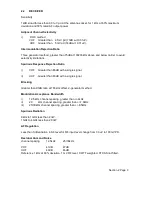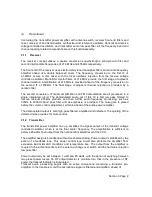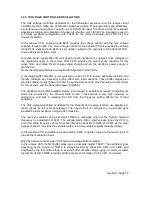
iii)
Radio Board
Containing the transmitter power amplifier with antenna switch, receiver front end filters and
mixer, receiver IF and demodulator, synthesizer and reference oscillator, transmit and receive
voltage controlled oscillators, and transmitter audio low pass filter. All the frequency band and
channel spacing related components are on this board assembly.
3.1.1
Receiver
The receiver concept utilizes a double conversion superhetrodyne principle with first and
second intermediate frequencies of 21.4 MHz and 455kHz respectively.
The front end of the receiver uses electronically tuned bandpass filters and a radio frequency
amplifier ahead of a double balanced mixer. The frequency conversion to the first IF of
21.4MHz occurs in this mixer with the local oscillator injection from the receive voltage
controlled oscillator. Monolithic crystal filters at 21.4MHz provide the first stage of adjacent
channel rejection. Amplification at 21 4MHz is provided ahead of the frequency conversion to
the second IF of 455kHz. The final stage of adjacent channel rejection is provided by a
ceramic filter.
The second conversion, IF limiter amplification and FM demodulation are all processed in a
single integrated circuit. The demodulated audio out of this IC is first low pass filtered to
remove residual 455kHz products and then further audio frequency processing, such as
300Hz to 3000Hz band pass filter and de-emphasis, is provided. The mute gate is placed
before the volume control adjustment, which is ahead of the audio power amplifier.
The demodulated output is also high pass filtered, amplified and detected. The quieting of the
detected noise provides for mute control.
3.1.2
Transmitter
The transmitter power amplifier line up, amplifies the signal output of the transmit voltage
controlled oscillator, which is at the final carrier frequency. The amplification is sufficient to
achieve 25 watts final output from the nominal 20 milliwatt level of the VCO.
The amplifier design is broadband without mechanical tuning. Power output is stabilized by the
action of a feedback loop. This power control loop circuit also protects the amplifier from
excessive load mismatch conditions and temperature rise. The output from the amplifier is
coupled to the antenna socket via the antenna change over switch and the harmonic rejection
low pass filter.
Power output may be set between 1 watt and 25 watts, with the option of switching between
two preset power levels. An RF output detector is monitored so that in the presence of RF
power the transmit indicator is illuminated.
Transmit audio processing begins with an active microphone containing a transistor pre-
amplifier. In the transceiver unit the microphone signal is filtered and amplified, ahead of
Section 3 Page 2
















































